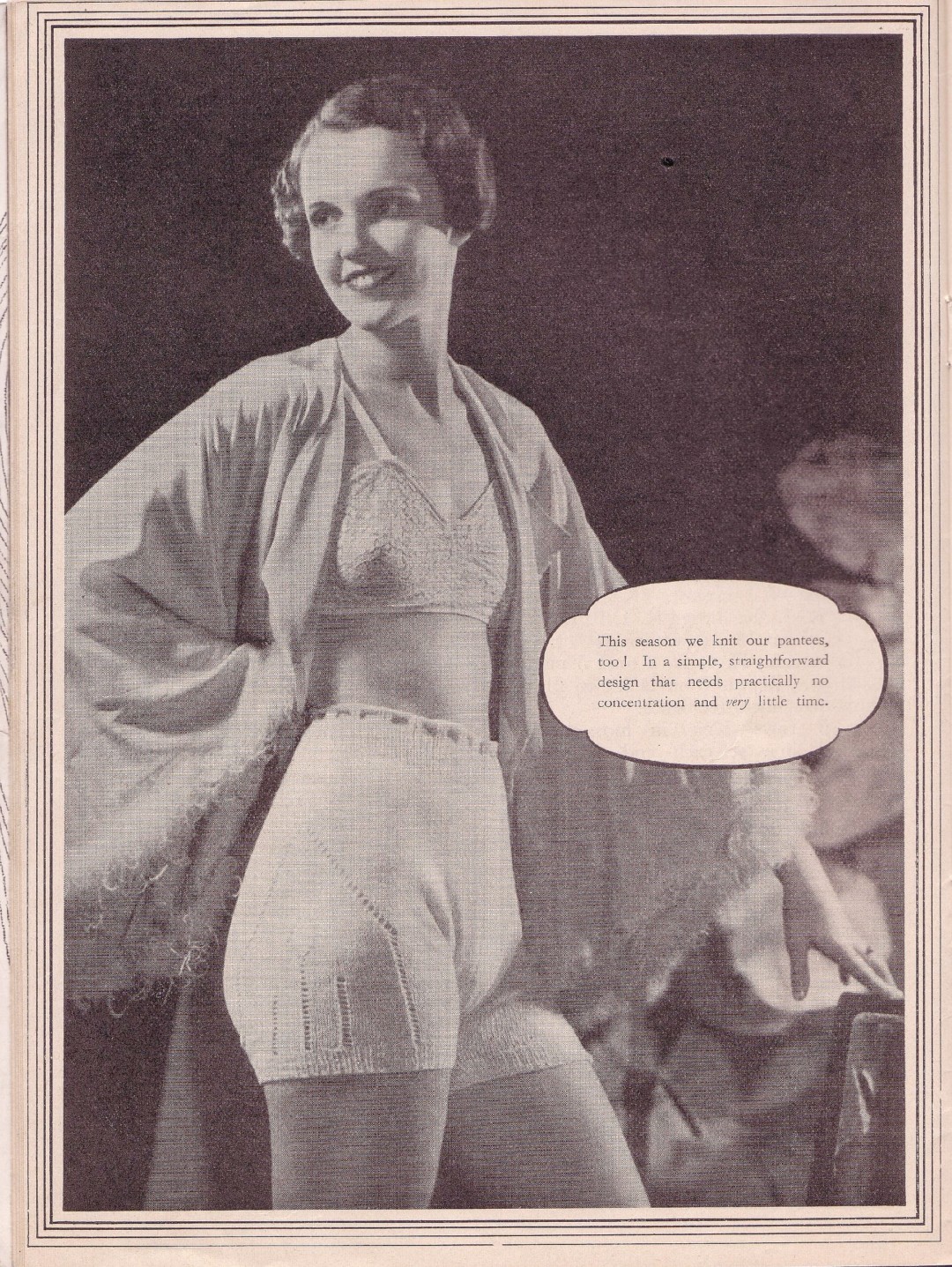My friend Sally adds to my collection of vintage knitting and sewing publications when she comes across them. She outdid herself a few years ago when she sent me a 1930s magazine together with this rather hysterical pair of knickers she’d knitted from a pattern in it. Only Sally would have the patience! Worked in very fine cotton, at a gauge of 10 stitches to the inch, it must have taken her weeks. ![P1230272 [HDTV (1080)]](http://chasingcentaurs.com/wp-content/uploads/2014/10/P1230272-HDTV-1080.jpg)
I can’t lay my hands on the pattern at the moment, but it was similar to this one in the 1935 Lux Book, published in Australia by Lever Brothers, which calls for 2-ply wool and “Tension of Knitting about 7sts and 9 rows to one inch.” 
![NPSCN(1).pdf18 [HDTV (1080)]](http://chasingcentaurs.com/wp-content/uploads/2014/10/NPSCN1.pdf18-HDTV-1080.jpg)
Well, compared to the gauge/tension of Sally’s valiant effort, I can see why the text trills that the design “needs practically no concentration and very little time.” Gulp. I seriously doubt that the average mother and housewife of those days, and it’s clear from the list of Contents that the Lux Book is aimed at her, had much time to spare on “pantees” such as these. ![NPSCN(1).pdf20 [HDTV (1080)]](http://chasingcentaurs.com/wp-content/uploads/2014/10/NPSCN1.pdf20-HDTV-1080.jpg)
Knitting garments for the family was often more of a necessity than the pleasurable pastime it is for many of us today. Lady Margaret was quite right about knitting though – “Nothing can stop it!” ![NPSCN(1).pdf19 [HDTV (1080)]](http://chasingcentaurs.com/wp-content/uploads/2014/10/NPSCN1.pdf19-HDTV-1080.jpg)
The Lux Book of 1941, like others before it, continued the trend of knitted underwear with patterns such as this, described as “Woman’s Vest in 3 sizes.” ![141005_01.pdf14 [HDTV (1080)]](http://chasingcentaurs.com/wp-content/uploads/2014/10/141005_01.pdf14-HDTV-1080.jpg)
![141005_01.pdf16 [HDTV (1080)]](http://chasingcentaurs.com/wp-content/uploads/2014/10/141005_01.pdf16-HDTV-1080.jpg)
![141005_01.pdf15 [HDTV (1080)]](http://chasingcentaurs.com/wp-content/uploads/2014/10/141005_01.pdf15-HDTV-1080.jpg)
The American publication of 1912 contains this little gem of a corset cover. Designed as underwear for the time, today, more than a century later and maybe with a bit less ribbon, it’s an attractive top.![WomansWeekly_01C [HDTV (1080)]](http://chasingcentaurs.com/wp-content/uploads/2014/10/WomansWeekly_01C-HDTV-1080.jpg)
![141005_01.pdf17 [HDTV (1080)]](http://chasingcentaurs.com/wp-content/uploads/2014/10/141005_01.pdf17-HDTV-1080.jpg)
Patons and Baldwins published many booklets, which contained useful knitting info and a wide variety of patterns. I’ve featured some here, together with the undergarments so popular at the time. You will note that the earlier publications tend to display the knickers modestly folded!![141005_01.pdf13 [HDTV (1080)]](http://chasingcentaurs.com/wp-content/uploads/2014/10/141005_01.pdf13-HDTV-1080.jpg)
![141005_01.pdf6 [HDTV (1080)]](http://chasingcentaurs.com/wp-content/uploads/2014/10/141005_01.pdf6-HDTV-1080.jpg)
Note the knitted petticoats, essential pieces of underwear for woman and girl.
This booklet is not dated, but the Art Deco cover indicates the period between the late1920s until the 1940s; I’m guessing somewhere in the ’30s. ![141005_01.pdf10 [HDTV (1080)]](http://chasingcentaurs.com/wp-content/uploads/2014/10/141005_01.pdf10-HDTV-1080.jpg)
![141005_01.pdf9 [HDTV (1080)]](http://chasingcentaurs.com/wp-content/uploads/2014/10/141005_01.pdf9-HDTV-1080.jpg)
![141005_01.pdf8 [HDTV (1080)]](http://chasingcentaurs.com/wp-content/uploads/2014/10/141005_01.pdf8-HDTV-1080.jpg)

![141005_01.pdf12 [HDTV (1080)]](http://chasingcentaurs.com/wp-content/uploads/2014/10/141005_01.pdf12-HDTV-1080.jpg)
![141005_01.pdf7 [HDTV (1080)]](http://chasingcentaurs.com/wp-content/uploads/2014/10/141005_01.pdf7-HDTV-1080.jpg)